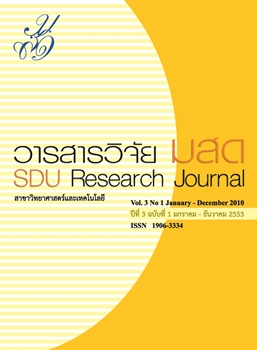มาตรการด้านความปลอดภัยทางชีวภาพสำหรับนักวิจัย (ทางชีวการแพทย์)
Keywords:
ความปลอดภัยทางชีวภาพ, ความมั่นคงทางชีวภาพ, การติดเชื้อทางห้องปฏิบัติการ, BIOSAFETY, BIOSECURITY, laboratory-acquired infections.Abstract
บทคัดย่อ
ในช่วงศตวรรษที่ผ่านมา การศึกษาวิจัยทางการแพทย์ช่วยให้มนุษย์มีสุขภาพที่แข็งแรงและอายุยืนยาวขึ้นโดยเฉพาะการป้องกันหรือค้นพบวิธีการรักษาโรคที่เกิดจากการติดเชื้อจุลชีพ ซึ่งการศึกษาวิจัยกับเชื้อจุลชีพนั้นต้องดำเนินการในห้องปฏิบัติการทางการแพทย์ที่มีมาตรการด้านความปลอดภัยทางชีวภาพ โดยการสร้างมาตรการความปลอดภัยทางชีวภาพนั้นมีวัตถุประสงค์เพื่อสร้างความปลอดภัยกับผู้ปฏิบัติงานเอง ปกป้องชิ้นงานที่กำลังดำเนินการศึกษาวิจัยอยู่ และเป็นการควบคุมป้องกันไม่ให้เกิดการแพร่กระจายของเชื้ออันตรายออกสู่สิ่งแวดล้อมภายนอกอย่างมีประสิทธิภาพ อย่างไรก็ตามแม้ว่าจะมีการสร้างมาตรการและแนวปฏิบัติที่ดี แต่ยังพบว่าอุบัติการณ์การติดเชื้อในห้องปฏิบัติการวิจัยอย่างต่อเนื่อง ในบทความนี้จะชี้ให้เห็นถึงความสำคัญของการสร้างมาตรการและหลักการด้านความปลอดภัยทางชีวภาพ การประเมินความเสี่ยง ระดับของห้องปฏิบัติการ ตลอดจนเสนอแนะแนวทางการเลือกให้อย่างเหมาะสม โดยมุ่งหวังว่านักวิจัยที่กำลังทำดำเนินการศึกษาวิจัยทางการแพทย์จะสามารถนำไปใช้ให้เกิดประโยชน์เพื่อลดความเสี่ยงของผู้ปฏิบัติงานและผู้ร่วมงาน ตลอดจนสิ่งแวดล้อมอีกด้วย
คำสำคัญ: ความปลอดภัยทางชีวภาพ; ความมั่นคงทางชีวภาพ; การติดเชื้อทางห้องปฏิบัติการ
Abstract
In the past century, medical research has led to improved health and increased life expectancy largelybecause of success in preventing and treating infectious diseases. This research must be conducted in biosafetycompliantlaboratories which are in accordance with many laws, regulations, policies, and well-establishedguidelines. Biosafety regulations are written to encompass protective measures against the risks of accidentalexposure or release occurring in laboratories that handle pathogens, or stock or manipulate potentiallycontaminated products, or perform microbiological tests for medical or scientific research purposes, as well asthe means of protecting the environment. Despite a greater awareness of biosafety practices, handling infectious microorganisms remains a source of infection, and even mortality, among laboratory researchers. Forthese reasons this review describes some aspects that include good microbiological practices, appropriatecontainment equipment, practices and operational procedures to minimize workers' risk of laboratory-acquiredinfections (LAIs). Application of this knowledge will enable the microbiological and biomedical community toprevent personal, laboratory and environmental exposure to potentially infectious agents or biohazards.
Keywords: BIOSAFETY; BIOSECURITY; laboratory-acquired infections.








